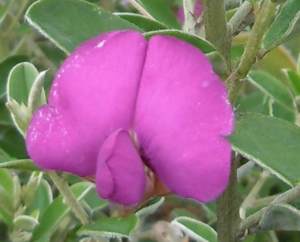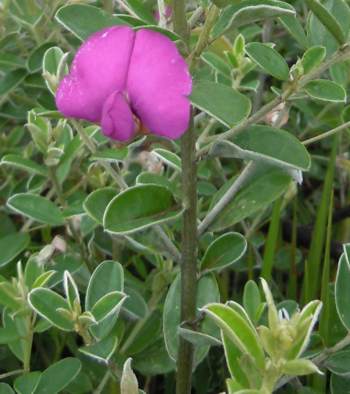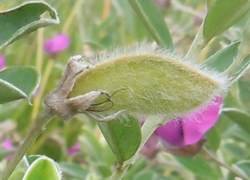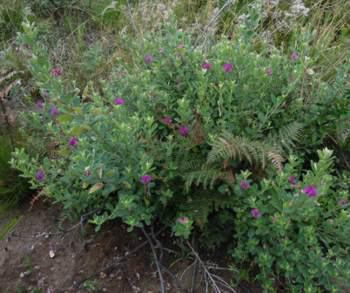Podalyria buxifolia
Podalyria buxifolia (Retz.) Willd.
Family: Fabaceae
Common names: box-leaf bush-sweetpea (Eng.); keurtjie (Afr.)
Introduction
Podalyria buxifolia is a delicately beautiful shrub from the southern Cape mountains. It has attractive, dark-green, glossy leaves and the most exquisite maroon, pea-like, scented flowers in summer. It is new to horticulture, but we believe it has good potential and is an excellent plant for the gardener wanting to attract bees, butterflies and birds to the garden.

Description
Description
Podalyria buxifolia is a spreading, well-branched, resprouting shrub growing to 1m high with a 2m spread. The leaves are simple, alternate, elliptic-oblong, 30mm long and up to 10mm wide with a pronounced midvein. They are dark, glossy-green on top and have silky white hairs on the lower surfaces that produce a silvery sheen. The stems are thin and wiry and yellowish green.

The attractive, magenta, and strongly fragrant flowers are held on long petioles arising from the axils of leaves near the branch ends. Flowering time is from August to April.
The flowers are followed by narrowly-inflated, hairy, green pods maturing to brown, approximately 40×15 mm. The pods dry to a crisp and split during hot weather to release several small seeds with fleshy, collar-like arils.

Conservation Status
Status
This species is not threatened.
Distribution and habitat
Distribution description
Podalyria buxifolia is a fynbos plant and occurs in the winter-rainfall Western and Eastern Cape from the western Outeniqua to the Kareedouw Mountains. It is found on sandstone slopes in kloofs (ravines), on moist hillsides, and on forest margins of 200-1000 m. Generally they do not grow in frost zones, however, mature plants may well survive frost as they can resprout. Young plants will therefore have to be protected. Plants will grow in temperatures between 5 and 35 degrees Celsius and require average to good winter rainfall, probably between 500 and 1000 mm per annum.
Derivation of name and historical aspects
History
The genus Podalyria was named by Lamarck after Podalirius / Podalyrius (Latin) from Podaleirios (Greek), the son of Asklepios, god of healing. According to the Iliad, Podaleirios and his brother Machaon were physicians to the Greek army during the Trojan Wars. The specific name buxifolia refers to its leaves being similar to the evergreen shrub genus Buxus, commonly called 'box', with the Latin folium meaning 'leaf'.
Podalyria belongs in the tribe Podalyrieae, subfamily Papilionoideae, family Fabaceae. Its closest relatives are the genera Virgilia, Cyclopia and Stirtonanthus.
Podalyria is a genus of 25 species, endemic to southern Africa. Most podalyrias occur in the winter rainfall region of South Africa, but some extend into the Eastern Cape and a few into the Northern Cape and KwaZulu-Natal. The best known species in the group is Podalyria calyptrata.
Ecology
Ecology
Podalyria buxifolia grows on hills and mountain slopes on poor, acidic, quartzitic soils. It is a resprouter with a persistent underground stem from which new shoots grow vigorously after fire or cutting. It also produces seeds which are expelled from dry pods. Seeds may be shot up to a metre away. Thereafter seeds are taken underground by ants which utilise the nutrient-rich aril. Seeds remain in the ground until the vegetation is removed by fire. The heat encourages the seeds to germinate.

Podalyria buxifolia flowers are very attractive to many insects, particularly carpenter bees, and nectar-feeders like honeybees, butterflies and hoverflies.
Uses
Use
Podalyria buxifolia has lovely flowers and it can be used for its horticultural potential.
Growing Podalyria buxifolia
Grow
Podalyria buxifolia is easily grown from seeds. Collect seed pods when they are dark brown, dry and beginning to split open. Place in a paper packet and put in a warm, dry place such as a windowsill where the pods can explode. The packet will prevent the expelled seeds from being lost. Store seeds in a bottle and drop some insecticide dust into the it before closing the lid. This will prevent predators from eating all the seeds.
Sow seeds in late summer or autumn, although they will probably germinate at any time of the year. First soak the seeds in hot water of about 80 degrees Celsius until the water has cooled. Sow the seeds into a well-drained, acidic, potting mix in trays, plugs or individual pots, and cover lightly. Place containers in a well-ventilated, warm, sunny position where the seeds are protected from rain. Sowing directly into plugs or pots minimizes root disturbance and maximizes the number of surviving seedlings. Do not over-water and allow the medium to dry out a little between waterings. The seeds germinate very quickly within three weeks.
Podalyrias, like most legumes, are very susceptible to pre-emergence damping off and treating the seeds with a fungicide to combat this will improve the percentage of surviving seedlings. These fungicides are available at your local nursery. The seedlings should be potted into small pots at cotyledon stage before the first pair of true leaves develop. The potting mix should be well drained. A mixture of equal parts well-rotted pine bark or compost and coarse river sand is recommended. The small plants should be fed every week or second week with an organic liquid fertiliser. The seedlings will establish relatively quickly and should be ready to be planted into the garden in 12 months.
Podalyrias generally do not root easily from cuttings, and the plants are never as strong as seed-grown plants. Podalyria buxifolia appears not to root from tip or heel cuttings taken from the main branches. However, this species roots well if heel cuttings are taken from the underground rootstock, otherwise known as rootstock cuttings. Rootstock cuttings can only be taken from mature plants that have developed an underground rootstock from which new shoots emerge. This is only possible when the plant is resprouting after fire or after being cut to the ground. Cuttings can only be taken from wild plants if you are in possession of a collecting permit and have landowner permission.
Podalyria buxifolia is a lovely spreading, openly branched shrub. It is perhaps best planted mixed with other medium-sized fynbos plants. More time will be needed to experiment to see what manicuring is needed to bring out the best in this species. It is likely that a mature plant should be pruned hard to the ground every few years to encourage it to resprout; this should also encourage flowering. To achieve a more compact, bushy specimen, plant it in full sun and pinch back young growth.
References
- http://Redlist.sanbi.org . Accessed on : 11 June 2014
- Manning, J. & Goldblatt, P. 2012. Plants of the Greater Cape Floristic Region 1: the Core Cape Flora. Strelitzia 29. South African National Biodiversity Institute, Pretoria.
- Moriarty, A. 1997. Outeniqua Tsitsikamma & Eastern Little Karoo. South African Wild Flower Guide 2. Botanical Society of South Africa, Cape Town.
- Vlok, J. & Schutte-Vlok, A.L. 2010. Plants of the Klein Karoo . Umdaus Press, Hatfield.
Credits
Anthony Hitchcock
Kirstenbosch National Botanical Garden
June 2014
Plant Attributes:
Plant Type: Scrambler, Shrub
SA Distribution: Eastern Cape, Western Cape
Soil type: Sandy
Flowering season: Spring, Early Summer, Late Summer
PH: Acid
Flower colour: Purple
Aspect: Full Sun
Gardening skill: Average, Easy
Special Features:
Horticultural zones







Rate this article
Article well written and informative
Rate this plant
Is this an interesting plant?
Login to add your Comment
Back to topNot registered yet? Click here to register.